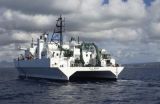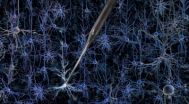(Press-News.org) Commercial ships travel across most of the globe and could provide better warnings for potentially deadly tsunamis, according to a study published May 5 by scientists at the University of Hawaii – Manoa (UHM) and the National Oceanic and Atmospheric Administration's Pacific Tsunami Warning Center.
James Foster, lead author and Assistant Researcher at the UH School of Ocean and Earth Science and Technology (SOEST), and colleagues were able to detect and measure the properties of the tsunami generated by the magnitude 8.8 earthquake in Maule, Chile (February 2010), even though, out in the open ocean, the wave was only about 4 inches (9.4 cm) high. The UH research vessel Kilo Moana was on its way from Hawaii to Guam at the time of the tsunami, and was equipped with geodetic GPS system recording data as the tsunami passed by.
Careful analysis of this data showed that the researchers were able to detect changes in the sea-surface height very similar to the Pacific Tsunami Warning Center predictions. This finding came as a surprise because tsunamis have such small amplitudes in the deep water, in contrast to their size when they reach the coastline, that it seemed unlikely that the tsunami would be detected using GPS unless the ship was very close to the source and the tsunami was very big. "Our discovery indicates that the vast fleet of commercial ships traveling the ocean each day could become a network of accurate tsunami sensors," Foster said.
Although the initial warning for a tsunami is based on seismic data from the earthquake, the details about whether a tsunami was actually generated, how big it is, and where the energy is directed are currently provided by tide gauges and deep ocean pressure sensors (DART system). This is the information that is needed to accurately predict how big the tsunami will be for specific locations, and whether or not an evacuation, and the associated cost, is necessary. Tide gauges are restricted to land and therefore are sparsely distributed, while the DART systems are very expensive and hard to maintain. Consequently, during the 2010 Chilean earthquake, the DART sensor closest to Hawaii was out of order. In fact, nearly 30% of that network was down at the time.
Commercial shipping lines, however, run all around the Pacific basin and provide great coverage globally around tsunamigenic regions (areas of the Earth that produced tsunamis). "If we could equip some fraction of the shipping fleet with high-accuracy GPS and satellite communications, we could construct a dense, low-cost tsunami sensing network that would improve our detection and predictions of tsunamis -- saving lives and money," Foster commented. Foster and co-authors estimate that this sort of ship-based system would have been able to detect the 2004 Indian Ocean tsunami within an hour, potentially save thousands of lives.
Foster and fellow SOEST researchers plan to deploy a demonstration system which will stream GPS data from one or two ships, thus generating accurate real-time heights and confirming that this approach can achieve the accuracy needed for tsunami detection. As a bonus, the same processing system will generate data that meteorologists can use to improve weather forecasts.
INFORMATION:
Research Contact: James Foster, Assistant Researcher, Hawaii Institute of Geophysics and Planetology, University of Hawaii – Manoa, (808) 956-7875, jfoster@soest.hawaii.edu
GPS on commercial ships could improve tsunami warnings
2012-05-08
ELSE PRESS RELEASES FROM THIS DATE:
US Army examines why some soldiers avoid PTSD care, strategies to keep them in treatment
2012-05-08
PHILADELPHIA, May 5, 2012 – U.S. Army researcher Maj. Gary H. Wynn, M.D., shared new analysis on why some Soldiers suffering from combat-related post-traumatic stress disorder (PTSD) never seek care or drop out of treatment early during a presentation today at the American Psychiatric Association's annual meeting. His presentation, "Epidemiology of Combat-Related PTSD in U.S. Service Members: Lessons Learned," also described the approaches the Army is using to address this issue and improve overall patient outcomes.
Currently, fewer than half of the Soldiers who report ...
A new candidate pathway for treating visceral obesity
2012-05-08
BOSTON, MA—Brown seems to be the color of choice when it comes to the types of fat cells in our bodies. Brown fat expends energy, while its counterpart, white fat stores it. The danger in white fat cells, along with the increased risk for diabetes and heart disease it poses, seems especially linked to visceral fat. Visceral fat is the build-up of fat around the organs in the belly.
So in the battle against obesity, brown fat appears to be our friend and white fat our foe.
Now a team of researchers led by Jorge Plutzky, MD, director of The Vascular Disease Prevention ...
Diabetic retinopathy research could reduce screening costs
2012-05-08
Research carried out at the Peninsula College of Medicine and Dentistry (PCMD), University of Exeter, has concluded that it would be a safe and cost-effective strategy to screen people with type 2 diabetes who have not yet developed diabetic retinopathy, for the disease once every two years instead of annually.
The research is supported by funding from the National Institute for Health Research Peninsula Collaboration for Leadership in Applied Health Research and Care (NIHR PenCLAHRC). It is published today (00:01hrs BST Monday 7th May 2012) on-line in Diabetes Care.
Diabetic ...
Eye color may indicate risk for serious skin conditions
2012-05-08
DENVER (May 6, 2012) - Eye color may be an indicator of whether a person is high-risk for certain serious skin conditions. A study, led by the University of Colorado School of Medicine, shows people with blue eyes are less likely to have vitiligo. It then follows, according to scientists, that people with brown eyes may be less likely to have melanoma. Vitiligo is an autoimmune skin disease in which pigment loss results in irregular white patches of skin and hair. Melanoma is the most dangerous kind of skin cancer.
The study is published online by the journal Nature ...
Robot reveals the inner workings of brain cells
2012-05-08
Gaining access to the inner workings of a neuron in the living brain offers a wealth of useful information: its patterns of electrical activity, its shape, even a profile of which genes are turned on at a given moment. However, achieving this entry is such a painstaking task that it is considered an art form; it is so difficult to learn that only a small number of labs in the world practice it.
But that could soon change: Researchers at MIT and the Georgia Institute of Technology have developed a way to automate the process of finding and recording information from neurons ...
Climatic effects of a solar minimum
2012-05-08
An abrupt cooling in Europe together with an increase in humidity and particularly in windiness coincided with a sustained reduction in solar activity 2800 years ago. Scientists from the German Research Centre for Geosciences GFZ in collaboration with Swedish and Dutch colleagues provide evidence for a direct solar-climate linkage on centennial timescales. Using the most modern methodological approach, they analysed sediments from Lake Meerfelder Maar, a maar lake in the Eifel/Germany, to determine annual variations in climate proxies and solar activity.
The study published ...
Liver fat gets a wake-up call that maintains blood sugar levels
2012-05-08
PHILADELPHIA –A Penn research team, led by Mitchell Lazar, MD, PhD, director of the Institute for Diabetes, Obesity, and Metabolism at the Perelman School of Medicine, University of Pennsylvania, reports in Nature Medicine that mice in which an enzyme called histone deacetylase 3 (HDAC3) was deleted had massively fatty livers, but lower blood sugar, and were thus protected from glucose intolerance and insulin resistance, the hallmark of diabetes.
Insulin resistance occurs when the body does a poor job of lowering blood sugars. Typically, patients with obesity and type ...
Multiple thought channels may help brain avoid traffic jams
2012-05-08
Brain networks may avoid traffic jams at their busiest intersections by communicating on different frequencies, researchers at Washington University School of Medicine in St. Louis, the University Medical Center at Hamburg-Eppendorf and the University of Tübingen have learned.
"Many neurological and psychiatric conditions are likely to involve problems with signaling in brain networks," says co-author Maurizio Corbetta, MD, the Norman J. Stupp Professor of Neurology at Washington University. "Examining the temporal structure of brain activity from this perspective may ...
Study shows Avastin has similar effect to Lucentis
2012-05-08
The one year results from a study into whether two drug treatments (Lucentis and Avastin), are equally effective in treating neovascular or wet age-related macular degeneration (wet AMD), have been reported today at an international research meeting in Fort Lauderdale, Florida.* The findings will also appear online shortly in the leading journal Ophthalmology.
Wet AMD is a common cause of loss of vision in older people. In the UK, around 70 per cent of people will experience severe loss of sight within two years of being diagnosed.
For four years, a team of scientists ...
LSU research finds orangutans host ancient jumping genes
2012-05-08
BATON ROUGE – LSU's Mark Batzer, along with research associate Jerilyn Walker and assistant professor Miriam Konkel, have published research determining that modern-day orangutans are host to ancient jumping genes called Alu, which are more than 16 million years old. The study was done in collaboration with the Zoological Society of San Diego and the Institute of Systems Biology in Seattle and is featured in the new open access journal Mobile DNA.
These tiny pieces of mobile DNA are able to copy themselves using a method similar to retroviruses. They can be thought of ...


